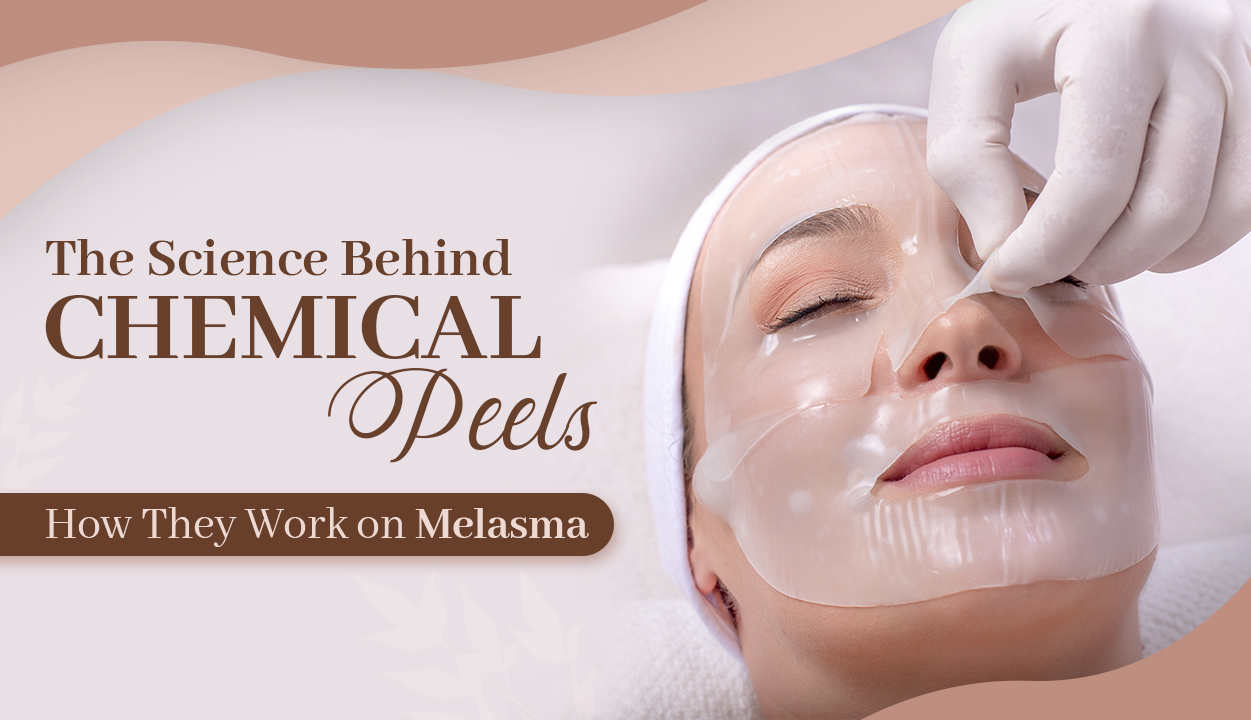
The Science Behind Chemical Peels: How They Work on Melasma
Melasma, often referred to as the “mask of pregnancy,” is a common skin condition causing dark patches, particularly on the face. This skin condition manifests as symmetrical hyperpigmentation, predominantly on sun-exposed areas like the face, forehead, cheeks, and upper lip. Melasma’s exact cause remains unknown, though hormonal changes, sun exposure, and genetic predisposition are considered vital contributors.
Melasma, the bane of many a skincare routine, can leave frustrating patches of discoloration on the face. But there’s hope! Chemical peels have emerged as a popular option for tackling this stubborn concern.
In this exploration, we’ll delve into the scientific intricacies of chemical peels, understanding how they work wonders in addressing this challenging dermatological concern.
The Science Behind Chemical Peels
Chemical peels offer a ray of hope for those grappling with melasma. But how do these treatments effectively tackle hyperpigmentation issues? The answer lies in their mechanism of action.
Exfoliation: Chemical peels contain active ingredients such as alpha hydroxy acids (AHAs), beta hydroxy acids (BHAs), or trichloroacetic acid (TCA). These agents work by exfoliating the outer layer of the skin, sloughing off dead cells, and revealing fresher, healthier skin beneath.
Melanin Inhibition: Certain chemical peels, particularly those containing ingredients like glycolic or kojic acid, possess melanin-inhibiting properties. These peels help diminish the appearance of dark patches associated with melasma by suppressing melanin production.
Collagen Stimulation: Beyond addressing this hyperpigmentation, chemical peels stimulate collagen production in the deeper layers of the skin. This collagen boost promotes skin renewal and regeneration, imparting a smoother, more youthful complexion.
Tailored Treatment Approach
Effective treatment of melasma demands a tailored approach, considering factors such as skin type, pigmentation severity, and individual response to various peel formulations. Not all peels are created equal. Choosing the right peel depends on several factors:
- Melasma severity and depth: Deeper melasma might require stronger peels like TCA, while milder cases might respond well to superficial options.
- Skin type and Fitzpatrick scale: Individuals with darker skin tones require extra caution to avoid post-inflammatory hyperpigmentation (PIH).
- Sun protection: Consistent, year-round sun protection is crucial before, during, and after treatment to prevent re-pigmentation.
The Importance of Sun Protection
While chemical peels offer remarkable benefits, diligent sun protection is paramount for maintaining results and preventing melasma recurrence. Broad-spectrum sunscreen, protective clothing, and sun avoidance during peak hours are indispensable measures in the battle against pigmentation woes.
Chemical peels are powerful tools in the fight against melasma, but it’s crucial to remember:
- Consult a dermatologist: Professional diagnosis and treatment planning are essential for the best results and minimizing risks.
- Realistic expectations: Melasma treatment is a journey, not a quick fix. Patience and consistent skincare are key.
- Maintenance is key: Even after successful treatment, maintaining a vigilant skincare routine with sun protection is vital to prevent recurrence.
Dermatologists often recommend a series of peels spaced at regular intervals to achieve optimal results while minimizing adverse effects.
In dermatology, chemical peels stand out as a potent weapon against melasma, offering hope and restoration to those afflicted by this challenging condition. Through exfoliation, melanin inhibition, and collagen stimulation, these treatments unveil a brighter, more radiant complexion, instilling newfound confidence in individuals’ skin.
However, it’s essential to consult with a qualified dermatologist to ensure safe and tailored chemical peel treatment. For more guidance, you can book an appointment with our dermatologist expert. Click here: https://shorturl.at/rtCD2 to schedule your appointment.
